Chapter I
The Emotional Core: A Psychological Deep Dive into Financial Accounts
The First Time You Open That App

You remember the first time you opened your Demat or brokerage account.
Your fingers hesitated before the login screen.
There was a faint mix of excitement “I’m finally doing this” and a quiet anxiety “What if I don’t understand what I’m looking at?”
Then, the numbers appeared.
Some in green, glowing softly like validation.
Some in red, sharp and intimidating, like silent reproach.
There were words you had never fully understood unrealized P&L, market value, average cost, holdings, margin.
You scrolled slowly, pretending to comprehend.
And in that private moment somewhere between curiosity and confusion you felt something many people never say aloud:
“I’m afraid of what this means about me.”
Because reading a financial statement isn’t just about money. It’s about self worth.
When you see profit, you feel smart. When you see loss, you feel small.
That’s where our journey begins not with charts or ratios, but with emotion.
Because until you understand what you feel when you look at your money, you’ll never truly understand what you see.
Why the Numbers Feel So Personal
Money was never designed to be emotional yet it has become the language of our deepest fears and desires.
When your portfolio goes up, your chest lightens. You feel competent, capable, maybe even visionary.
When it goes down, your mind races: Was I wrong? Should I sell? Should I have waited?
It’s the same number just seen through two different emotional lenses.
Psychologists call this loss aversion our tendency to feel the pain of loss twice as strongly as the joy of gain.
But here’s the hidden truth:
You’re not reacting to money itself. You’re reacting to what money means to you safety, success, security, or belonging.
This is why two people can see the same market correction and feel entirely different emotions.
For one, it’s opportunity. For another, it’s panic.
The market didn’t change the mind did.
The Emotional Architecture of Your Demat Account
Your Demat account may look like a grid of numbers, but beneath it lies a subtle map of your emotional architecture the patterns through which you relate to uncertainty.
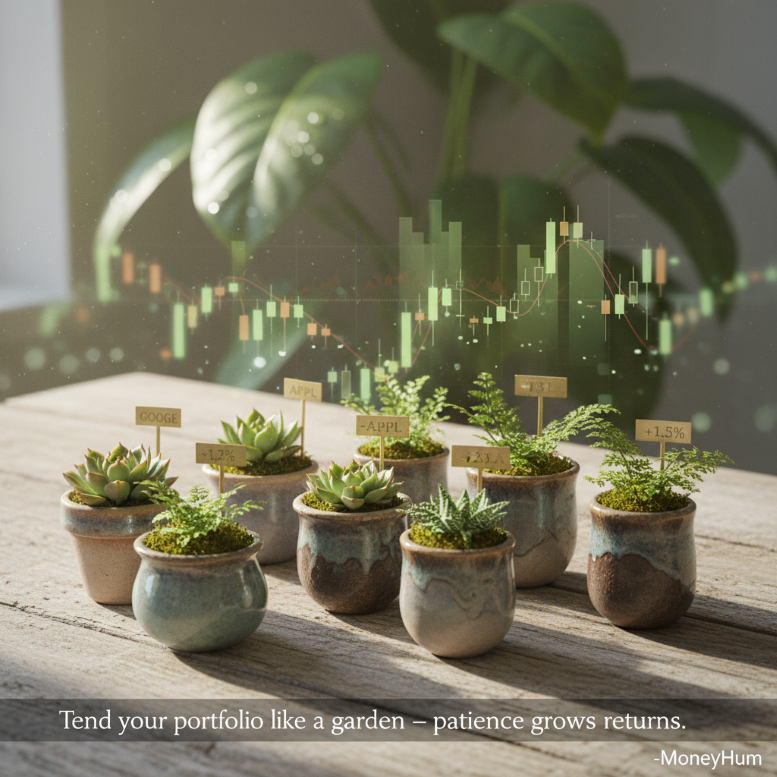
Here’s how most people subconsciously experience it:
| Section You See | What Your Mind Translates It As |
|---|---|
| Portfolio Value ↑ | “I’m doing well. I’m smart.” |
| Portfolio Value ↓ | “I failed. I should’ve known.” |
| Unrealized Profit/Loss | “My potential self versus my present self.” |
| Holding Quantity | “Control or the illusion of it.” |
| Market Price | “The world’s judgment on my decision.” |
| Average Cost | “A record of my past am I proud or embarrassed of it?” |
Each of these isn’t just data it’s a mirror.
It reflects how comfortable you are with ambiguity, patience, and imperfection.
That’s why, before we learn to read the Demat account logically, we must learn to read it psychologically.
The Quiet Shame of Financial Confusion

There’s a quiet shame that many new investors carry:
The fear of not understanding what others seem to understand effortlessly.
You might have read articles, watched videos, even attended webinars yet the interface still feels foreign.
You see “average price” and “LTP” and nod along, hoping clarity will arrive one day.
But it doesn’t.
So you avoid opening the app altogether. You delay checking your statements. You tell yourself, “I’ll learn later.”
That avoidance is not laziness it’s self protection.
Your brain associates financial data with threat not because it’s dangerous, but because it represents judgment.
In behavioral psychology, this is called avoidance coping.
It’s what we do when facing something that challenges our sense of adequacy.
And this is precisely where emotional investing begins not in greed or risk taking, but in avoidance born out of shame.
The Psychological Biases Hiding Behind Every Login
Let’s name them gently, without judgment.
Because once you see these patterns clearly, you begin to regain calm.
- Loss Aversion: You fear losses more than you value gains. That’s why you feel uneasy when your portfolio dips, even temporarily.
- Recency Bias: You judge everything by what just happened. A week of decline feels like “the end.” A rally feels like “this is it!”
- Anchoring Bias: You fixate on your purchase price. If you bought at ₹100, you want it back even if ₹98 or ₹102 is inconsequential in the long run.
- Confirmation Bias: You seek information that agrees with your current belief bullish or bearish and ignore the rest.
- Overconfidence Bias: You believe you can “time” it because you guessed right once. You forget luck has a loud voice in the market.
Every portfolio whether beginner or veteran carries these emotional fingerprints.
Your Demat account is not just an investment tool; it’s a psychological MRI.
It shows where your patience lives and where your panic hides.
The Emotional Illusion of “Control”

If you’ve ever refreshed your brokerage app ten times a day, waiting for the market to move your way you know this feeling.
It’s the illusion of control.
The human brain craves predictability, especially in chaotic environments like the stock market.
By “checking,” you subconsciously feel like you’re doing something.
But watching your holdings more often doesn’t improve your returns. It only intensifies your emotional volatility.
Imagine this:
You plant a seed. You water it, then dig it up every hour to see if it’s grown.
That’s what most of us do with our portfolios.
The wise investor knows growth happens in silence.
You nurture, not inspect.
That silence is not ignorance. It’s trust.
When Fear Becomes Paralysis
One of the most common experiences new investors face is analysis paralysis wanting to learn everything before acting.
You tell yourself:
“Once I understand all the terms, I’ll start.”
“Once I’m confident about the market, I’ll invest.”
“Once I know how others do it, I’ll buy my first stock.”
But knowledge doesn’t come before experience it comes from it.
The Demat account, in that sense, is like a musical instrument.
You don’t learn it by watching others play you learn by touching the keys, by hearing mistakes, by practicing patiently.
Your first few trades or SIP setups are not failures they’re familiarization.
Every misstep teaches you a new emotional language:
the language of patience, restraint, and learning to lose gracefully.
The Comparison Trap
There’s another emotion quietly entangled with money: comparison.
We don’t just compare returns we compare timelines, risks, and even luck.
You see a friend post about a stock that doubled. You look at your portfolio modest, slow moving, “boring.”
Suddenly, your peace feels inadequate.
But the truth is your financial journey is not a race.
The only real benchmark is your emotional steadiness.
Every investor who grows wealth sustainably learns this sooner or later:
“I’m not investing to impress others. I’m investing to sleep peacefully at night.”
The ones who rush, chase, or compare eventually circle back to this simple truth serenity beats speed.
The Emotional Evolution of an Investor
Every beginner moves through three stages not of knowledge, but of emotional growth.
- Curiosity: The first spark opening the account, watching the numbers move. The joy of potential.
- Confusion: Realizing that it’s not as easy as it looks. Facing losses, volatility, and inner turmoil.
- Composure: Accepting that emotions are part of the process. Beginning to act with calm detachment.
And then, one day maybe years later you open your Demat account, see red, and feel… nothing alarming.
You simply note it. You understand it. You act when needed.
That’s not indifference that’s maturity.
It’s the quiet confidence that comes when knowledge and patience finally meet.
The Healing Begins with Awareness
You can’t eliminate fear from investing. But you can befriend it.
Fear, when understood, becomes caution a healthy guardrail.
Shame, when understood, becomes curiosity a desire to learn.
So before we move to the technical and mathematical side of reading your Demat account, pause for a moment and ask yourself:
- What do I feel when I see my investments rise or fall?
- What do I believe about money that makes me anxious or impatient?
- What would it mean to me if I became financially calm, not just financially rich?
Because once you begin to answer those, you’ll realize:
Your Demat account isn’t just showing you your financial performance
it’s showing you your emotional patterns.
Reflection Pause
Take a quiet moment tonight.
Log into your Demat account. Don’t analyze, don’t react.
Just observe.
Look at each number as a teacher, not a verdict.
Every green number whispers, “Here’s what patience creates.”
Every red one says, “Here’s where resilience grows.”
This isn’t about making peace with losses it’s about making peace with yourself.
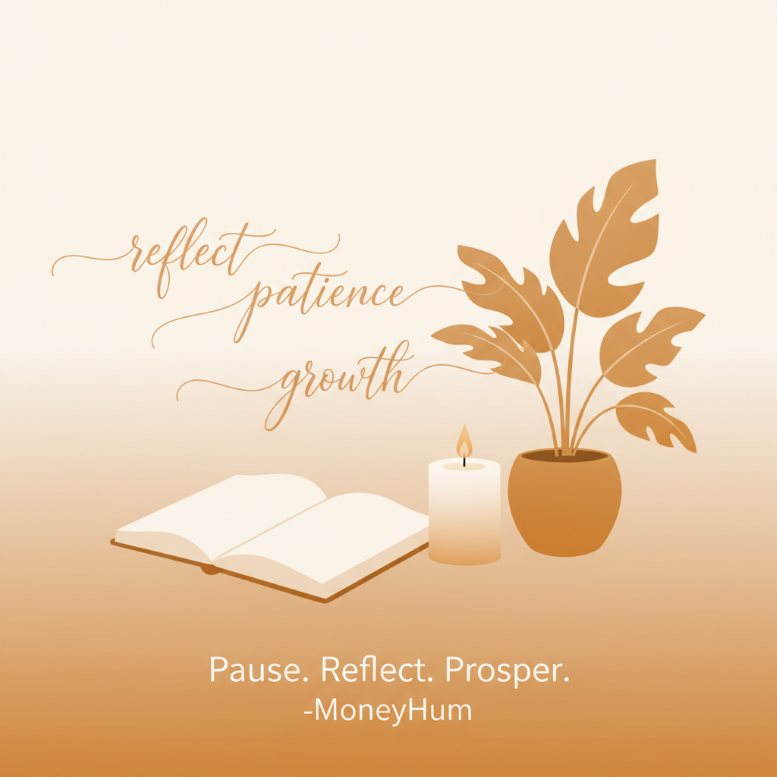
Chapter II
Behavioral Finance: Why Your Mind Colors the Market Data
“You don’t see markets as they are. You see them as you are.”
The Psychology of Reading: What Your Mind Sees vs. What’s Actually There
The Mind Behind the Numbers

Every time you open your brokerage app or check your Demat statement, something interesting happens long before your eyes register the figures, your mind has already started making sense of them.
It doesn’t read data; it reads meaning.
- A 3% drop feels like danger.
- A ₹2,000 profit feels like relief.
- A new all time high feels like validation.
What’s happening here isn’t financial analysis it’s emotional interpretation.
And the most remarkable part? You’re not even aware it’s happening.
This is how most investors live: reacting not to information, but to their emotional translation of information.
In psychology, this is called affect heuristic a mental shortcut where emotions shape our decisions faster than logic can intervene.
It’s the same mechanism that makes you avoid checking a portfolio during a market crash or feel euphoric when you see “+₹10,000” in green.
So before we even talk about reading a Demat account correctly, we need to understand how our inner world colors the outer one.
Seeing Through the Lens of Emotion
Imagine two people Asha and Rohan.
They both bought the same stock at ₹200. Today, it’s ₹150.
- Asha sees this as an opportunity. “It’s a great company. I’ll buy more.”
- Rohan sees it as a punishment. “Why did I ever trust this stock?”
What changed? Not the data.
Only their interpretation.
Asha’s mind translates the fall as temporary volatility.
Rohan’s mind translates it as personal failure.
That’s the silent truth behind every portfolio the mind’s narrative determines how you react more than the market’s movement.
And that narrative is shaped by your past: how your parents handled money, what early financial experiences you had, how you interpret success and failure.
When you begin to notice these stories within, something incredible happens you stop being a reactive trader and start becoming a reflective investor.
Why We Struggle to See Clearly
Human beings are not designed to process uncertainty with grace.
Our brains evolved for survival not for the stock market.
In the wild, uncertainty meant danger.
Today, in the markets, it just means volatility but our biology can’t tell the difference.
When you see your portfolio drop, the amygdala (the brain’s emotional alarm system) lights up.
Your heartbeat quickens, cortisol rises, and the body enters a mild stress state as if you’ve encountered a threat.
That’s why “staying calm” during market swings isn’t just about discipline it’s about rewiring physiology.
And this is also why the most successful investors aren’t necessarily the smartest they’re the calmest.
As Warren Buffett once said:
“The market is a device for transferring money from the impatient to the patient.”
Patience, biologically speaking, is an act of emotional regulation.
When you learn to observe a drop without panic, you’re not just being disciplined you’re literally training your nervous system to stay wise under pressure.
The Three Layers of Reading
When you open your Demat account, you think you’re reading financial data.
In truth, you’re reading three layers of information at once.
| Layer | What It Represents | Emotional Impact |
|---|---|---|
| 1. Literal Layer | The data itself holdings, prices, returns, etc. | Neutral (if seen objectively) |
| 2. Interpretive Layer | The story you tell yourself about those numbers (“I’m up”, “I’m behind”, “I made a mistake”) | Emotional highs and lows |
| 3. Identity Layer | What you believe it says about you (“I’m smart”, “I’m bad with money”, “I can’t trust myself”) | Deep emotional patterns |
Most investors think they’re dealing with the first layer data.
But their actions are driven by the third identity.
That’s why market knowledge alone doesn’t make you wise.
Wisdom begins when you can see all three layers clearly and say to yourself:
“This number is not me. It’s just information.”
That single insight, practiced over time, can change your financial life.
The Stories We Tell Ourselves
Every investor, consciously or unconsciously, carries a story about money.
Here are some common ones:
- “I always miss opportunities.”
- “I don’t have luck like others.”
- “I need to recover my losses fast.”
- “I’m not good with numbers.”
- “The market is against me.”
These are not objective truths they are emotional scripts.
And until you question them, they quietly dictate how you act.
For example:
If you believe “I always miss opportunities,” you’ll chase every new tip you hear not because it’s logical, but because you’re trying to rewrite your story.
If you believe “I’m not good with money,” you’ll hesitate to invest even when the data is clear because you fear confirming your own narrative.
Understanding your Demat account, therefore, is not just about reading financial statements it’s about rewriting the inner script that decides how you see them.
The Mind’s Hidden Tricks: Cognitive Biases in Action
Let’s look at some of the invisible distortions your brain introduces while reading your Demat account and how to notice them calmly.
Understanding and Mitigating Core Cognitive Biases
1. Anchoring Bias
You fixate on your buy price as the “right” number.
If you bought at ₹400 and it’s now ₹380, you feel loss.
If it rises to ₹420, you feel gain.
But in truth, neither number means anything without context.
Companies evolve, markets change your anchor doesn’t.
How to correct it:
Anchor to time horizon and business quality, not price.
Ask: “Has my reason for investing changed?” instead of “Is it back to my cost?”
2. Confirmation Bias
You only seek data that agrees with what you already believe.
If you’re bullish, you read optimistic reports.
If you’re bearish, you look for warnings.
You don’t want truth you want comfort.
How to correct it:
Play devil’s advocate with yourself.
Before every decision, ask:
“What would convince me that I’m wrong?”
3. Recency Bias
You assume the recent past will continue forever.
If the market has been rising for months, you expect it to rise further.
If it’s falling, you fear it’ll keep falling.
How to correct it:
Zoom out. Look at a 5 year chart instead of a 5 day one.
Context neutralizes emotion.
4. Overconfidence Bias
You mistake luck for skill.
A few profitable trades convince you you’ve “cracked” the market.
Then, overexposure follows and lessons arrive.
How to correct it:
Journal every trade with why you made it.
When outcomes don’t match logic, humility grows.
5. Availability Heuristic
You overestimate the importance of news that’s easy to recall.
If you recently read a crash headline, you’ll fear it’s imminent even if data says otherwise.
How to correct it:
Replace news consumption with data observation.
The market moves slower than the media makes it seem.
6. Disposition Effect
You sell winners too early and hold losers too long.
Why? Because you want to feel right.
Selling profit feels good; selling loss feels like admitting failure.
How to correct it:
Set exit rules before entering.
When rules replace emotion, wisdom begins.
Why We Love Green and Fear Red
Have you ever noticed how your body reacts to color?
A screen full of green numbers makes you feel uplifted.
Red makes you tense, defensive, even anxious.
It’s no accident.
Brokers deliberately use these colors because they trigger instinctive responses.
But once you’re aware, you can neutralize their control.
Some experienced investors even switch their screen themes to grayscale removing emotional color cues.
The less stimulus your mind gets, the more rational your choices become.
How Perception Shapes Behavior
Think of your Demat account as a mirror not just of markets, but of your mindset.
- If you read it with fear, you’ll act reactively.
- If you read it with ego, you’ll overtrade.
- If you read it with greed, you’ll overexpose.
- But if you read it with curiosity, you’ll grow.
Perception shapes not only reaction but frequency of checking.
Studies in behavioral finance have found that investors who check their portfolios too often tend to earn less not because markets punish them, but because emotions interrupt compounding.
Every time you act on impulse buying high or selling low you pay the price of impatience.
In a way, emotion is the most expensive brokerage fee.
The Mind’s Quiet Rebellion: Control vs. Acceptance
We all crave control.
We want to believe that if we read enough, predict enough, plan enough we’ll master uncertainty.
But markets are designed to humble that illusion.
The real mastery isn’t in prediction it’s in acceptance.
To read your Demat account without needing it to validate you.
To see a loss and think, “This is part of the process.”
To see a gain and think, “This doesn’t make me invincible.”
That is emotional neutrality the rarest skill in investing.
It doesn’t mean detachment. It means composure.
You care deeply, but you act calmly.
The Shift from Reactivity to Reflection
When you begin to see your emotional patterns clearly, a subtle but powerful transformation happens.
Instead of reacting to numbers, you start reflecting on them.
You look at your portfolio not as a scoreboard, but as feedback.
A way to learn about yourself.
Where do I panic?
Where do I wait too long?
Where do I get greedy?
Each answer makes you wiser not richer immediately, but richer in awareness.
And that awareness eventually compounds, too.
Because clarity is the only capital that never depreciates.
Reflection Pause
The next time you open your Demat account, notice what happens in your body first.
Your breath.
Your shoulders.
Your pulse.
Before you analyze the data, analyze yourself.
That awareness practiced daily is your true edge.

Chapter III
Technical Breakdown: The Math of Your Demat Account
“Clarity is not the absence of complexity. It’s the calm that lets you see through it.”
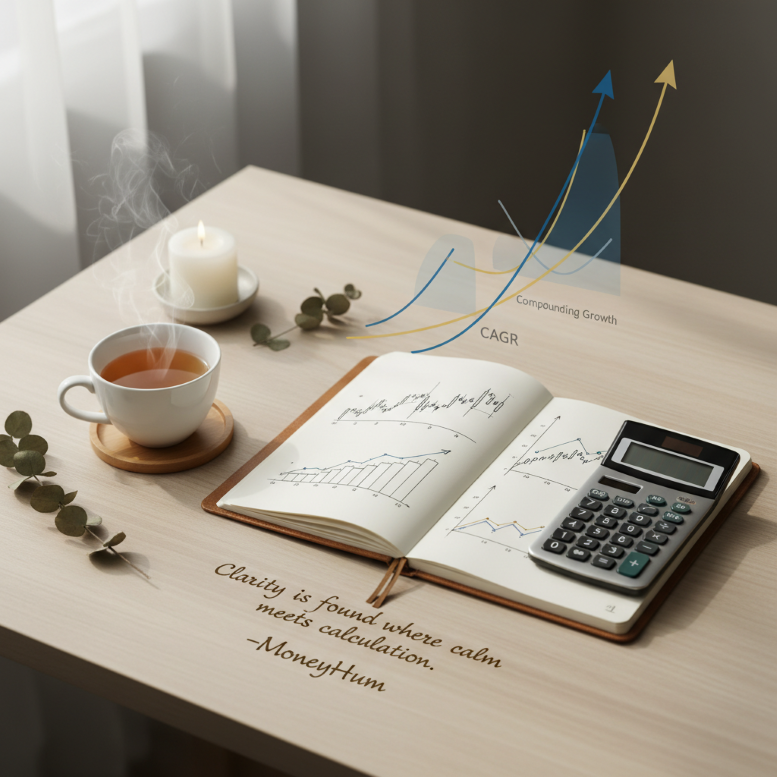
The Core Components of Your Investment Dashboard
When you open your Demat account, what you see is not chaos it’s a language you haven’t yet learned to read with ease.
Each number has agr story. Each column, a purpose.
But the trick is this:
You don’t have to understand everything at once.
Just like learning a new language, you begin with meaning, not mastery.
Your Demat and brokerage account is a map of your financial landscape your holdings, your cost, your market value, and your performance.
It tells you not only what you own, but how your decisions have aged.
And if you learn to read it patiently, it can become one of the most empowering self awareness tools in your financial life.
Demat vs. Trading Account: Clearing the Confusion
Before we go deeper, let’s clear the most common confusion.
| Term | Purpose | Analogy |
|---|---|---|
| Trading Account | Where you buy and sell securities. | Like the cash counter in a store where exchange happens. |
| Demat Account | Where your securities are stored digitally. | Like a digital locker where the stocks you’ve purchased are safely kept. |
Think of it like this:
- You use your Trading Account to make transactions.
- The shares you buy get stored in your Demat Account.
- The two are connected but serve different roles.
When you “check your portfolio,” you’re usually looking at the Demat side your holdings, their value, and your overall wealth in listed form.
The Core Sections of Your Portfolio Dashboard
Let’s walk through the key sections of a typical Demat/brokerage account and the deeper meaning behind each.
1. Holdings
This section lists all your investments stocks, ETFs, mutual funds, or bonds you own.
Each line item typically shows:
- Stock Name
- Quantity Held
- Average Cost
- Current Market Price
- Market Value
- Unrealized Profit/Loss
This is the heart of your portfolio.
It’s where you see what you’ve chosen to believe in companies, sectors, or funds that represent your convictions.
2. Positions
This section reflects active trades the shares you’ve bought or sold recently (especially in intraday or F&O).
It shows:
- Buy Price
- Sell Price
- Profit/Loss (Realized) This area changes frequently it’s for traders, not long term investors.
If you’re a beginner, your calm lies mostly in Holdings, not Positions.
3. Orders
Here you can track your placed, pending, or completed orders showing you transaction history, execution times, and order types (market, limit, stop loss).
It’s the “activity log” of your decisions.
4. Funds or Ledger
Shows your available balance both cash and margin (if you trade derivatives).
It includes:
- Added funds
- Withdrawals
- Brokerage or transaction charges
- Taxes like STT (Securities Transaction Tax) and stamp duty
This is where the “hidden math” of trading lives the costs that often go unnoticed but affect your returns significantly.
5. P&L Statement (Profit & Loss)
This report reveals your realized profits and losses the difference between what you bought and sold.
For long term investors, this helps in tracking CAGR (Compounded Annual Growth Rate) and XIRR (Extended Internal Rate of Return) two key metrics we’ll decode shortly.
The Math Behind Common Portfolio Terms
Let’s translate what you often see in human terms.
| Term | Meaning | Emotional Translation |
|---|---|---|
| Average Cost | The average price you paid per unit of stock. | “What my belief in this company cost me.” |
| LTP (Last Traded Price) | The current price of the stock in the market. | “What others currently believe it’s worth.” |
| Market Value | Current price × quantity held. | “The present reflection of my past choices.” |
| Unrealized P&L | Profit or loss if you sold today. | “The what if scenario but not the truth yet.” |
| Realized P&L | Actual gain/loss from sold stocks. | “The financial echo of my past decisions.” |
| CAGR | Compounded Annual Growth Rate measures annualized return over a period. | “How efficiently my patience has paid off.” |
| XIRR | A more accurate metric for irregular cash flows (like SIPs). | “My personalized compounding speed.” |
Each of these numbers tells you something not just about performance but about your temperament.
Do you chase highs?
Do you panic at dips?
Do you stay consistent?
The math shows the results but the meaning shows you.
The Real Story: Unrealized vs. Realized Profit
When you see green numbers in your portfolio, they’re often unrealized meaning, the profit exists only on paper until you sell.
It’s tempting to count it as income, but that’s emotional math, not financial math.
Unrealized profit = Potential.
Realized profit = History.
Many investors fall into the trap of celebrating potential gains and then feeling devastated when the market corrects.
A calm investor celebrates something else entirely discipline.
They understand that the journey from unrealized to realized is not a race. It’s a reflection of timing and temperament.
How to Calculate Your True Returns
Numbers can deceive if you don’t know which ones matter.
Here’s how to make them tell the truth calmly and clearly.
1. CAGR Compounded Annual Growth Rate
This tells you how much your investment has actually grown per year.
CAGR — Compounded Annual Growth Rate
This tells you how much your investment has actually grown per year.
Formula:
CAGR = (Final Value / Initial Value)^(1/n) – 1
Example:
You invested ₹1,00,000 five years ago. Today it’s worth ₹1,61,000.
CAGR = (1,61,000 / 1,00,000)^(1/5) – 1 = 0.10 (or 10%)
So your portfolio grew at 10% annually even if some years were volatile.
It’s not about yearly noise; it’s about average peace.
2. XIRR For SIP or Irregular Investments
When you invest monthly or at varying intervals, CAGR doesn’t tell the full story.
That’s where XIRR comes in.
It accounts for when money was invested and when returns came in.
It’s what SIP investors should focus on it reflects the true compounding pace of habit, not just capital.
Think of XIRR as your emotional ROI the reward for staying consistent even when results were invisible.
Understanding Brokerage, STT, and Other Costs
Your Demat isn’t just about growth it’s about friction.
Every transaction carries small invisible costs that silently shape your long term returns.
| Cost Type | What It Is | How It Impacts You |
|---|---|---|
| Brokerage Fee | The commission your broker charges per transaction. | Varies by platform; choose low cost brokers. |
| STT (Securities Transaction Tax) | Tax on each buy/sell transaction. | Usually small but adds up with frequent trades. |
| Stamp Duty & Exchange Fees | State and exchange level charges. | Fixed per trade, negligible for long term. |
| DP Charges | Demat Provider fees when you sell. | Around ₹10–₹25 per transaction. |
| GST on Brokerage | Tax on brokerage fee itself. | A fraction of a percent, but visible in statements. |
💡 Insight:
If you’re a frequent trader, these small charges can silently erode returns sometimes more than the loss you fear.
That’s why long term investing feels calmer less friction, less noise, more compounding.
Reading Volatility with Logic, Not Emotion
Volatility is the movement of prices. But emotionally, it feels like a movement of identity.
When the portfolio swings, you feel unstable.
That’s because humans naturally equate stability of self with stability of outcomes.
But the two are not the same.
The market’s volatility is not your volatility.
To remind yourself of that truth, try this:
- Track your portfolio once a month, not daily.
- Compare 1 year and 5 year CAGR, not daily percent change.
- Focus on consistency of contribution, not consistency of return.
Because investing is not a test of prediction it’s a practice of peaceful participation.
Diversification: The Mathematical Form of Emotional Balance
Diversification isn’t just a risk tool it’s an emotional regulator.
It prevents any single outcome from dominating your mental state.
When you’re diversified across asset classes equities, debt, gold, and international funds one part of your portfolio stabilizes another.
Mathematically, diversification lowers volatility.
Psychologically, it lowers anxiety.
A good portfolio feels like a well balanced life no extreme highs or devastating lows, just quiet, steady growth.
For a practical guide to diversification in 2025, explore:
↗ Best Investment Options in India for 2025: A Guide to Risk, Return, and Emotional Investing
How to Read Your Portfolio Like a Professional
Here’s a gentle step by step process you can adopt each month:
- Check Allocation, Not Emotion: See how your investments are spread equity, debt, mutual funds. Avoid zooming into temporary red or green.
- Look at CAGR/XIRR: Don’t obsess over short term profit. Focus on overall growth rhythm.
- Identify Outliers: Any stock or fund drastically outperforming or underperforming? Revisit your thesis calmly.
- Check Costs and Taxes: Review your brokerage and DP charges once a quarter. Small leaks can sink long term peace.
- Reflect, Don’t React: Ask: “What does this teach me about my patience?” Because data is just feedback not judgment.
This is what professionals do.
They don’t just analyze numbers they listen to them.
The Mathematical Truth About Compounding
Compounding is not magic it’s mathematical patience.
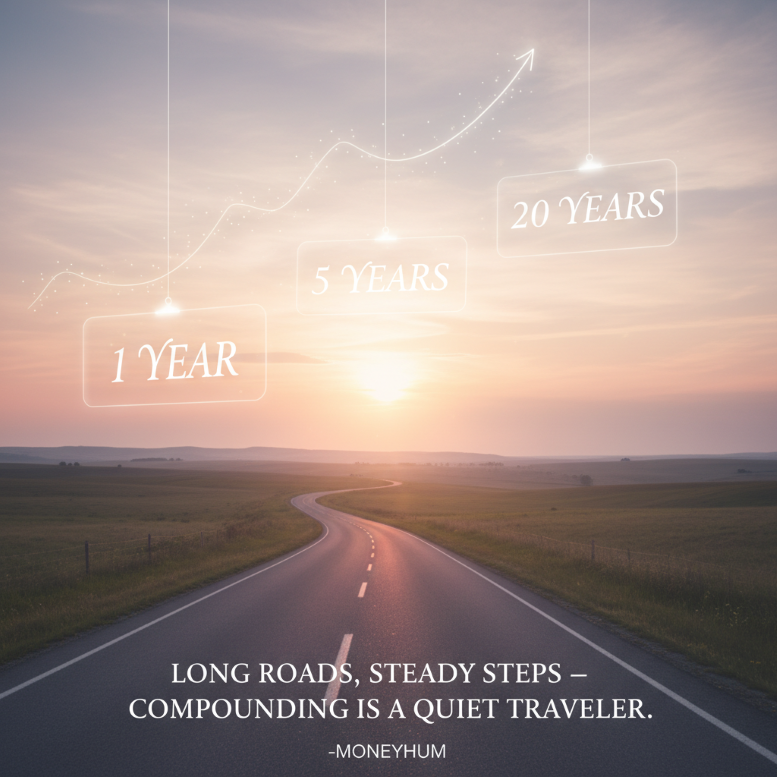
Let’s see what small, consistent action can really do:
| Monthly Investment (₹) | Time (Years) | Average Return (CAGR) | Final Value (₹) |
|---|---|---|---|
| 5,000 | 10 | 10% | 10,32,000 |
| 5,000 | 20 | 10% | 34,49,000 |
| 5,000 | 30 | 10% | 94,96,000 |
What changed?
Not the effort just time.
And here lies the most profound truth of the Demat world:
You don’t need to read every line perfectly.
You just need to stay long enough for the math to become magic.
Reflection Pause
Open your portfolio today and look at your numbers differently.
Not as judgments, but as evidence of your consistency.
The small, steady investments they are not insignificant.
They are your quiet rebellion against financial anxiety.
They’re proof that calmness, when practiced long enough, becomes compounding.

Chapter IV
Actionable Wisdom: Building a Nurturing Portfolio Relationship
“Investing is not about controlling the market. It’s about learning to dance with uncertainty, one calm step at a time.”

Bridging Emotion and Action: Building a Relationship with Your Portfolio
From Numbers to Relationship
Some people check their portfolio every few minutes.
Some don’t open it for months.
Both extremes come from the same place emotion.
The first group checks constantly because they crave control.
The second avoids it because they fear disappointment.
True wisdom lies somewhere between in relationship.
To read your Demat account regularly, but without anxiety.
To review it with curiosity, not urgency.
Because your portfolio is not a test you pass or fail it’s a relationship you nurture.
And like every meaningful relationship, it needs attention, boundaries, and trust.
The Ritual of Monthly Reflection
Let’s create a quiet ritual around your portfolio one that transforms checking into mindful reviewing.
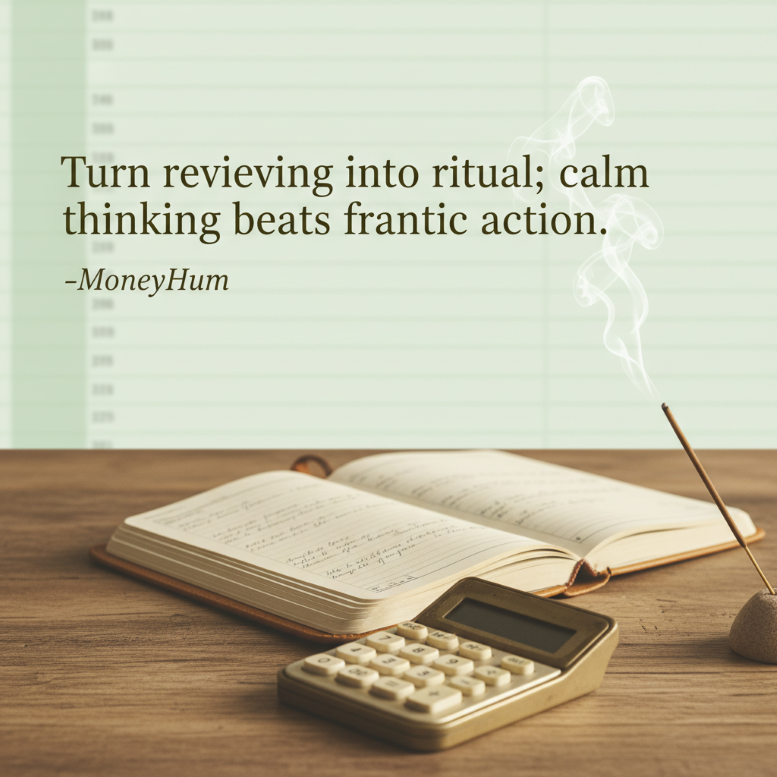
Step 1: Choose a Peaceful Time
Don’t open your portfolio when the market is live.
Do it on a weekend morning or a calm evening.
Let it be a space of reflection, not reaction.
Step 2: Set the Intention
Before logging in, pause and remind yourself:
“I am here to understand, not to judge.”
This single thought softens your nervous system.
It shifts your focus from performance to perspective.
Step 3: Review the Whole, Not the Headlines
Look at your asset allocation (equity, debt, mutual funds, gold) not the daily fluctuations.
Zoom out to see progress over 1–3 years, not 1–3 days.
You’re looking for direction, not distraction.
Step 4: Journal Briefly
Note down key feelings and learnings:
- “I felt anxious about stock X’s fall.”
- “I’m proud I didn’t panic sell.”
- “I might rebalance next month.”
Writing separates emotion from identity.
You begin to witness your behavior, not drown in it.
Step 5: End with Gratitude
Close the app.
Take one deep breath.
Whisper, “I’m learning.”
Because that’s what all of this truly is a lifelong practice in emotional intelligence.
How Often Should You Check Your Portfolio?
This is one of the most misunderstood habits in personal finance.
There’s no one size fits all rule, but there is one golden principle:
“Check as often as you can without disturbing your peace.”
For most long term investors, once a month is perfect.
For active traders, once a day is enough.
Anything more is emotional checking not financial monitoring.
Research by Meir Statman (a behavioral finance pioneer) found that investors who check their portfolios too often earn lower returns, simply because their decisions become more emotional.
So, if you want your money to grow quietly give it space to breathe.
Building Emotional Boundaries
To build a calm relationship with your investments, you need boundaries not barriers, but gentle rules of self care.
Here are three that will protect your peace:
Boundary 1: No impulsive action within 24 hours of panic
If a stock crashes, don’t act that day.
Let emotion cool.
Truth reveals itself in hindsight, not heat.
Boundary 2: Avoid portfolio checks right after market hours
Your mind is most vulnerable when prices settle it’s hungry for validation.
Instead, review at a neutral time (weekends are perfect).
Boundary 3: Keep numbers separate from self worth
A red screen does not mean failure.
It means volatility the heartbeat of growth.
When you start seeing red as normal, you’ve graduated emotionally.
Rebalancing: The Art of Gentle Correction
Every few months, your portfolio drifts from its intended balance.
Maybe equity grew faster than debt, or gold dipped below target.
That’s when you rebalance not as punishment, but as care.
Rebalancing is emotional hygiene.
It prevents overconfidence in bull markets and despair in bear ones.
It’s a quiet way of saying to your money:
“I see you. I’m keeping us steady.”
For example:
If your goal is 70% equity and 30% debt, and now it’s 80–20, sell a bit of equity to buy debt.
You’re not timing; you’re tidying.
This discipline feels small but it compounds into emotional serenity.
The Healing Power of Automation
If you’ve ever felt that manual investing stresses you out automate it.
Automation is not laziness. It’s emotional design.
By automating SIPs (Systematic Investment Plans), you outsource decision making to discipline.
You invest regularly, rain or shine.
You no longer need to ask, “Is today a good day to invest?”
Every day becomes one.
Automation turns emotion into rhythm.
To build your SIP habit systematically, you can read:
↗ Build a Strong SIP Habit: Your Simple 12-Month Plan for Beginners
When Your Portfolio Shows Red: The Lesson of Acceptance
Every investor faces the moment when their screen bleeds red.
It feels personal like an accusation.
But in truth, it’s a test.
That redness is not failure it’s feedback.
It says: “The market is re pricing your patience.”
If you can stay still in that moment breathe, observe, not sell impulsively
you grow more than your portfolio ever could.
Because the ultimate skill in investing isn’t prediction it’s patience under pressure.
Remember this:
“A fall in price does not mean a fall in value.
A rise in price does not mean a rise in wisdom.”
Calm investors understand the difference.
They don’t need every candle chart to rise to feel okay inside.
The Wisdom of Doing Less
We live in an age of constant alerts price triggers, analyst calls, breaking news.
It’s easy to believe more action equals more progress.
But the opposite is true.
Doing less, consciously, is emotional mastery.
Checking your Demat account less often, trading less frequently, and tweaking less aggressively
these are not acts of neglect. They’re acts of confidence.
The best investors don’t micromanage their portfolios.
They design systems that work and then trust them.
They’ve learned what most people never realize:
“Peace is a performance enhancer.”
For deeper insight into this truth, see:
↗ The Hidden Cost of Constant Hustle: Why Doing Less Earns More
The Portfolio as a Mirror of Self Growth
Look at your portfolio again not as money, but as a mirror.
- The stocks you bought too soon? They reflect your impatience.
- The SIPs you’ve sustained? They reflect your discipline.
- The investments you never made? They reflect your fear of loss.
Every number is feedback about who you’re becoming.
And as your financial maturity grows, your emotional landscape changes too.
There comes a day when you stop needing your portfolio to make you feel secure because you’ve become secure within yourself.
That’s real wealth.
The Bridge Between Emotion and Math
Let’s bring together everything we’ve learned so far:
| Emotional Insight | Mathematical Practice |
|---|---|
| Fear of loss | Diversification + Long horizon |
| Overconfidence | Journal trades + Rebalance |
| Impatience | SIP automation + Monthly check ins |
| Shame or confusion | Education + Journaling |
| Comparison | Focus on XIRR + Personal benchmarks |
The math anchors the mind;
the mind gives meaning to the math.
That’s the full circle of financial maturity.
Reflection Pause
Next time you review your portfolio, don’t ask:
“How much did I make?”
Instead, ask:
“How much did I grow in patience, clarity, and understanding?”
Because those are the real assets the ones no market crash can take away.

Chapter V
Mindset Mastery: The Investor’s Journey to Emotional Wealth
“The goal is not to master money. The goal is to no longer be mastered by it.”
Reflection and Empowerment: Reading Yourself Through Money

The Moment It Finally Makes Sense
There comes a moment quiet, almost imperceptible when your Demat account stops intimidating you.
You open it, see green or red, and feel… nothing alarming.
You simply observe.
The anxiety that once rushed through your chest softens.
You start to see patterns, not panic.
This is what real financial literacy feels like.
Not excitement, not fear but clarity.
It’s the day you realize your portfolio isn’t judging you.
It’s simply reflecting your journey through patience.
The Portfolio as a Mirror of Inner Growth
Every investor’s portfolio is a mirror not of performance, but of personality.
- The stocks you refused to sell, even when logic said otherwise? That was attachment.
- The times you bought too quickly after a friend’s tip? That was insecurity disguised as urgency.
- The quiet months where you simply stayed consistent? That was maturity.
Over time, your portfolio becomes your biography.
Not of money but of mindset.
Each entry in your Demat account tells a story of who you were when you made that choice.
Each update reveals who you’re becoming now.
When you read your account this way, it stops being a spreadsheet it becomes a spiritual journal in numeric form.
Redefining “Profit” and “Loss”
We’ve been taught that profit means gain and loss means failure.
But that’s a limited definition one that keeps us trapped in emotional volatility.
In truth:
- A profit is not just a financial win it’s the reward of clarity, patience, and proportion.
- A loss is not failure it’s tuition. You paid for wisdom in a currency called experience.
Every investor who’s truly successful carries a history of losses but they call them lessons.
Because those red marks taught them things no bull market ever could.
Your Demat account, in that sense, is not just an investment statement it’s a classroom.
And every month, it teaches you about your ego, your resilience, and your relationship with uncertainty.
The Emotional ROI
You’ve heard of Return on Investment (ROI).
But have you ever measured your Emotional ROI?
It’s not in percentages. It’s in peace.
Ask yourself:
- Do I check my portfolio less anxiously than before?
- Can I stay calm when markets fall?
- Am I able to trust the process more deeply now?
If the answer is yes even slightly then you’re growing in ways spreadsheets can’t measure.
That’s your true wealth the kind that builds both freedom and peace.
Redefining Wealth: Beyond Net Worth
Wealth is not how much money you have it’s how little you worry about it.
Real wealth is measured in the quietness of your mornings, the freedom of your time, and the confidence to say no when the world demands hurry.
The people who are truly rich are not those who never face losses but those who are emotionally unshaken by them.
They’ve learned what the market really teaches:
“Control is an illusion. Awareness is power.”
The Power of Stillness in Investing
When you stop needing your portfolio to constantly rise, it starts to grow with grace.
Stillness is not stagnation it’s strategic calm.
It’s what separates the trader who panics from the investor who prospers.
Stillness doesn’t mean you never act.
It means you act only when clarity outweighs emotion.
It’s the wisdom of doing less beautifully, deliberately, and with presence.
If you’d like to go deeper into this philosophy, explore:
↗ The Path to Real Wealth: Why Patience and Compounding Beat Shortcuts
↗ The Hidden Cost of Constant Hustle: Why Doing Less Earns More
When You Stop Comparing
Comparison is the thief of peace especially in finance.
When you compare portfolios, you stop hearing your own rhythm.
When you chase someone else’s returns, you lose your emotional grounding.
But when you define success in your own terms
when you say, “I want consistency, not chaos”
you enter a state of quiet wealth.
That’s the moment you reclaim your agency.
You stop performing for the market.
You start partnering with it.
The Long Game: Compounding Beyond Money
Compounding is not just a financial principle it’s a philosophy of life.
When you invest regularly, you’re not just compounding money.
You’re compounding patience.
You’re compounding resilience.
You’re compounding emotional intelligence.
Every SIP, every month, is a statement of faith that says:
“I trust the future enough to stay consistent in the present.”
And over time, that mindset bleeds into other areas
You become more patient in relationships.
More grounded at work.
Less reactive in uncertainty.
Money becomes your teacher.
And your Demat account your meditation space.
Healing Your Relationship with Money

Let’s be honest most of us grew up in environments where money meant tension.
Either there wasn’t enough, or there was too much attachment to it.
As adults, we carry those emotional residues the fear of scarcity, the guilt of abundance, the constant sense that we’re behind.
But you can heal this quietly, slowly, gently.
Each time you open your Demat account without fear, you rewrite that childhood script.
Each time you resist impulsive panic, you heal a part of yourself that once feared loss.
Your portfolio becomes a canvas where you paint emotional maturity.
For more on this emotional healing aspect of finance, you can also explore:
↗ Financial Anxiety Is the Modern Disease: How to Heal Money Fear & Stress
↗ Emotional Spending Psychology: Why We Buy What We Don’t Need (And How to Stop)
The Quiet Confidence of Emotional Maturity
There’s a kind of investor who doesn’t brag about returns.
They don’t check prices ten times a day.
They don’t post screenshots.
They are calm, deliberate, content.
They understand that financial maturity is not about being rich it’s about being at peace with what you have, while calmly building what you need.
That’s who you’re becoming not just a better investor, but a wiser human.
What the Market Can’t Teach (But You Can Learn)
The market will never stop testing you.
It will rise and fall, whisper and roar.
But the real test isn’t whether you make money
it’s whether you can stay kind, clear, and centered when things don’t go your way.
Because the greatest investment returns aren’t in your account
they’re in your character.
Reflection Pause
Take one last look at your portfolio tonight.
Don’t analyze. Don’t measure.
Just notice how far you’ve come emotionally, intellectually, financially.
Remember: You are not your numbers. You are your awareness of them.
And as that awareness grows, your peace will too.
🌿 The Closing Arc: The Calm Investor’s Code

Let’s end with five simple truths quiet, rational, grounding:
- Your Demat account is not your report card. It’s your reflection showing your relationship with uncertainty.
- Patience is your greatest compounding force. Time multiplies both capital and calm.
- Emotion is data too. Don’t suppress it observe it. Learn its patterns.
- Wealth is internal first. External abundance flows from inner security.
- Progress isn’t perfection it’s consistency. Every calm decision is a small victory of maturity.
The Final Word
In the end, learning to read your Demat account is not about decoding numbers it’s about decoding yourself.
It’s about learning to see without judgment, act without fear, and grow without noise.
When you reach that place of quiet clarity, you’ll realize:
Money was never the goal.
It was the mirror the one that showed you how to grow beyond it.
“Peace is the highest dividend. Patience is the best compounding. Awareness is the truest wealth.”
If you’ve read this till the end, thank you❤️
With love,
Your Dearest Friend,
Chitraansh







